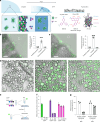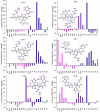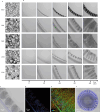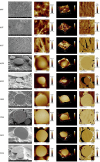Adaptive peptide dispersions enable drying-induced biomolecule encapsulation
- PMID: 40764824
- PMCID: PMC12404992
- DOI: 10.1038/s41563-025-02300-z
Adaptive peptide dispersions enable drying-induced biomolecule encapsulation
Abstract
Peptides are promising building blocks of designer materials with wide-ranging applications. These materials are stabilized by directional hydrogen-bonding patterns, giving rise to one-dimensional or two-dimensional assembly. It remains a challenge to mimic biology's context-adaptive and flexible structures. Here we introduce minimalistic tripeptide sequences that form highly soluble dynamic ensembles through multivalent side-chain interactions. We observe these supramolecular dispersions undergo drying-induced sequential liquid-liquid phase separation followed by solidification, resulting in the formation of films of stiff, densely packed and porous peptide microparticles that can be instantaneously redispersed upon the re-introduction of water. Air-drying of peptide dispersions in the presence of proteins or small-molecule payloads results in efficient encapsulation and the retention of protein stability after redispersion, showing promise for the emulsification, encapsulation, protection and storage of biomacromolecules. The mechanism resembles the protective strategies in natural systems during desiccation, which rely on liquid-liquid phase separation to survive extreme conditions.
© 2025. The Author(s).
Conflict of interest statement
Competing interests: R.V.U., Y.H., M.C., L.X., D.R.D., S.K. and M.T.-N. have submitted a patent application related to the phase separation, encapsulation and preservation technology described in this work. R.V.U. and M.C. are cofounders of BioWraptor, a company with a potential interest in licensing this technology.
Figures















References
-
- Zhang, S. Fabrication of novel biomaterials through molecular self-assembly. Nat. Biotechnol.21, 1171–1178 (2003). - PubMed
-
- Ghadiri, M. R., Granja, J. R., Milligan, R. A., McRee, D. E. & Khazanovich, N. Correction: self-assembling organic nanotubes based on a cyclic peptide architecture. Nature366, 324–327 (1993). - PubMed
-
- Kaygisiz, K. et al. Context dependence in assembly code for supramolecular peptide materials and systems. Nat. Rev. Mater.10, 449–472 (2025).
MeSH terms
Substances
Grants and funding
LinkOut - more resources
Full Text Sources

